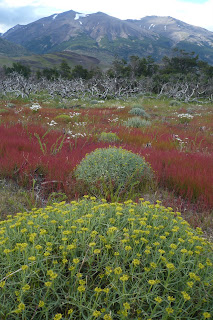Well, I got back to Sitka last night, and now I am planning to move to Juneau to study. Two reasons to be a little wistful, but I am curious to see what is going to happen.
So after I left Torres del Paine, I took a six-hour bus trip to Punta Arenas (the largest city in the region), and then a thirty-some hour bus trip to Valdivia, where I just walked around, drank excellent local beers, and ate a fish that made me horribly sick for a couple of days. My next destination was the Cajon del Maipo, but by the time I got there I was just too weak to do any high-altitude hiking so I went to Santiago to relax for my last few days. In the end, the bus trip was basically just a long exercise in suffering. The only upshots are that I saved a lot of money by not flying, and that I saw the Coscoroba swan and the lesser seedsnipe during a maintenance stop in the middle of the pampa in Argentina.
Santiago is, well, a big city. I spent a lot of time walking, drinking coffee, reading, and taking advantage of cultural activities such as museums, street performers, a representation of "Twelfth Night" in Russian with subtitles in antiquated spanish (my first play with subtittles - very odd), literary cafes, etc. But I missed the simplicity of my volunteering days, people were just not very friendly, and even in the city "green belt", drinking untreated river water was just out of the question.

I then went to Valparaiso because I was feeling better and well, it's a mythical city after all, I just couldn't miss it. Valparaiso was indeed quite fascinating, with lots of interesting people and things to do. There was even a little of birding to do, with inca terns and grey gulls in the harbor. I went to see a free puppet show at Neruda's house , which was by far the best live show I have seen during this entire trip. The kids in the audience were half the fun, as they kept talking to the characters and the artists who would talk back, shift roles, and exploit zones of ill-defined identity (for lack of a better term). For example, the character of the devil exists, and doesn't exist, inhabits other puppets, and then tells the kids that the devil doesn't exist - it's just a character some puppeteers chose to represent evil. But then again, as the kids will tell him loudly - he obviously is the devil!

I also went to Viña del Mar, and to see natural stands of Ocoa palm trees.
On my last day, when I had finally recovered some strength and appetite, I went hiking in Parque Nacional La Campana near the charming town of Olmue, where I made a light and fast (2.5 hours to the top) ascent of Cerro La Campana, a rather unimpressive 1800 meter mountain (1400 meters from the base) that is mostly known for having been climbed by Darwin.
I was hoping to see a giant hummingbird on the mountain. I didn't, but I was not disappointed because I made incredible observations of moustached turca, dusky tapaculo, aplomado falcon, and many birds I had seen before such as the white-throated tree-runner which is uncommon this far north. I also saw a lot of interesting plants, such as this interesting solanacea, Schizanthus hookeri:

.


























